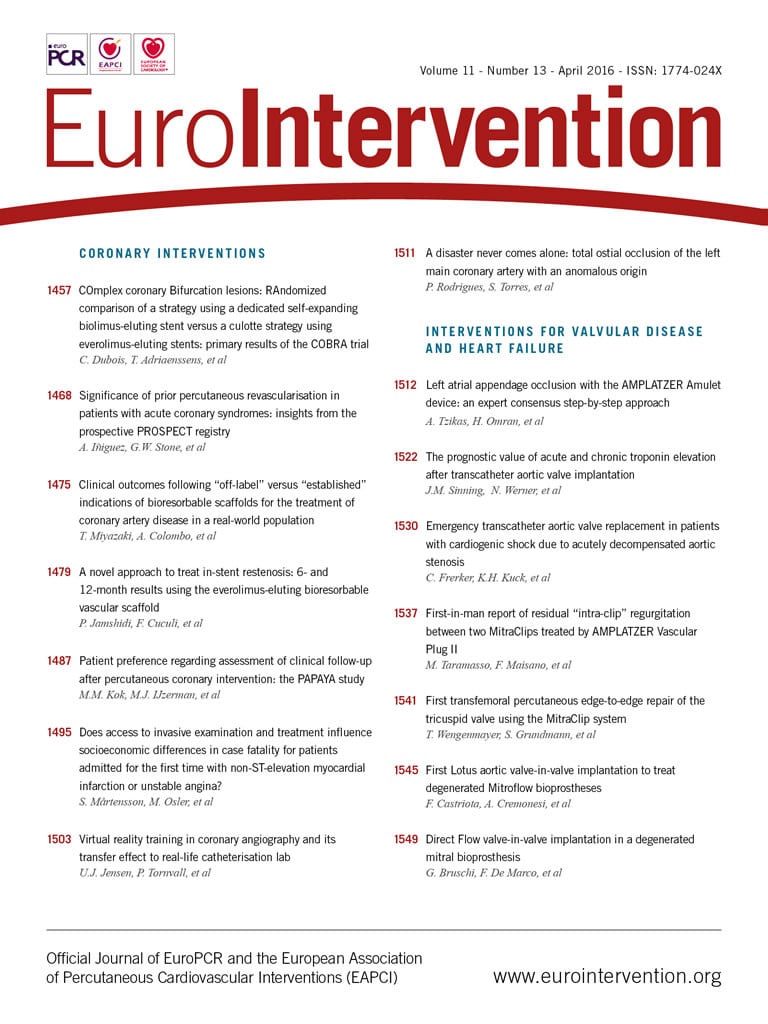In 1977, when Andreas Gruentzig was treating his first patient, he was of course confronted with the basic question of which treatment should be administered post-vessel injury. Whom did he consult to resolve the problem? It was said at the time that he consulted the rising star in the field of atherothrombosis, a young Spanish cardiologist who had just emigrated to the United States, Valentin Fuster. Only Valentin himself can confirm whether this story is true or not, whether Andreas consulted him or not, but the fact is that Andreas used aspirin in his patients to control the thrombotic process that could result in vascular injury by balloon dilation. At that time, aspirin was stopped after the critical period for restenosis. All of us young cardiologists at the time followed his therapeutic approach. It was only seven years later, in 1984, that Margaret Thornton (who by the way was his second wife) published a randomised study in Circulation that demonstrated the superiority of aspirin1.
Another seven years on, in 1991, JoAnn Manson published a paper confirming a mortality benefit for females after studying US registered nurses (n=87,678) aged 34 to 65 years who received a single daily administration of at least 80 mg aspirin for life2. From that moment on, aspirin was administered for life. In the same year, we reported the results of the first 105 patients with the WALLSTENT™ (Boston Scientific, Marlborough, MA, USA), with an occlusion rate of 25%3. We became engaged in aggressive anticoagulation regimens, differing by study site, including different combinations of aspirin, dipyridamole, warfarin, heparin, urokinase and sulfinpyrazone, all of which generated major bleeding issues. In the CAPRIE trial, the benefit of clopidogrel over aspirin was shown in terms of combined risk of ischaemic stroke, myocardial infarction or vascular death4. Without any doubt, CAPRIE brought clopidogrel to the fore. The next development came from Michel Bertrand, who investigated the concept of dual therapy with ticlopidine and aspirin. His investigations showed that this led to reduced bleeding and subacute stent occlusions as compared to the conventional anticoagulation used at that time5. It was then that dual antiplatelet therapy (DAPT) became a “must” for stent implantations. Paul Barragan in Marseille and Marie-Claude Morice together with Jean Marco in Toulouse popularised this approach before it reached the German investigators and crossed the Atlantic where it was to be tested by Martin Leon. Martin showed that ticlopidine was the indispensable second antiplatelet medication for a one-month duration6.
In 2000, as the result of the CLASSICS study, one month of ticlopidine was replaced by clopidogrel due to an improved safety profile (e.g., leukopenia), and it was demonstrated that the 300 mg loading dose of clopidogrel was well tolerated, with no increase in bleeding7. At the time of the introduction of the CYPHER® (Cordis, Johnson & Johnson, Fremont, CA, USA) stent in the FIM studies in Sao Paolo and Rotterdam, the duration of DAPT for this first DES was arbitrarily administered for two months8, since Cordis initially intended to conduct an observational study in the Far East using ticlopidine and aspirin for two months. Perhaps forgotten today, the RAVEL study allowed only two months of clopidogrel9. For some obscure reason, when DES crossed the Atlantic, clopidogrel was administered for a period of three months in the SIRIUS study10 and in the TAXUS-IV study for six months11. In parallel, it was discovered that there was a benefit of 12 months in patients with acute coronary syndrome after DES implantation12.
This is what we call a historical accident in the pharmacological treatment of post-percutaneous coronary intervention.
The P2Y12 polymorphism was discovered with clopidogrel. There was a need to overcome the interindividual variability associated with clopidogrel13 which led to the beginning of the era of prasugrel and ticagrelor; however, aspirin remained in the background. Certainly, the ESC “storm” in 2006 did little to facilitate any attempt to remove aspirin from the combined treatment. The US FDA advisory panel that took place in December of 2006 supported the empirical recommendation of 12 months DAPT after DES placement, determining that this guideline be incorporated in DES product labelling. This recommendation was not based on any prospective randomised trial-based evidence associating extending DAPT with a reduction of late stent thrombosis, but rather it was based on consensus opinion. In an editorial, shortly after the FDA panel meeting, we concluded that studies on DAPT were urgently needed14.
One decade later, we now have two different “clubs” working on DAPT. The first group is mainly obsessed by the nuisance and the risk of bleeding and the other is pre-occupied by the long-term prevention of stent thrombosis and long-term atherothrombosis in general.
It falls beyond the scope of this editorial to go into the detail of the 13 DAPT studies reported, but, with the exception of the Mauri et al report15, we think it is fair to say that we should exert caution when interpreting the studies in general due to some shortcomings in the reports such as underpowering to detect differences in hard endpoints, the slow enrolment, patients lost to follow-up and underreporting.
What is puzzling is that most of the stent manufacturers such as Abbott, Boston Scientific and Medtronic, have obtained an endorsement, a kind of labelling, from the CE mark body for three-month DAPT usage. Yet, it remains unclear for the average physician on which data the CE body took this decision. The EAPCI chairman tried to obtain some information to justify the decision on three months of DAPT, but at the present time there is no transparency in the data used by the CE body in the EU, something which is in stark contrast with what occurs in the USA. It is remarkable that the CE body, a device approval entity assessing not only medical devices but also household appliances such as fridges, hairdryers and curling tongs, is giving a recommendation for a pharmaceutical therapy.
What is the future?
Today, we still see a lot of conventional DES usage picking up this pharmacological debate, generated, as we said, by a historical accident, to promote or create additional trials with various duration times (three versus six months, six months versus 12 months, etc.). Some of us believe that the LEADERS FREE study16 was, from that point of view, a landmark trial, since it addressed an unmet need in the use of DES in patients at high risk of bleeding, and it now becomes an ethical must to test and provide information with abbreviated DAPT usage.
Whilst we don’t take any risk in trying to predict the future, we think the obvious question to be asked today is what is the place of aspirin? An original pathway of research would be to investigate monotherapy for efficacy and also for the reduction in risk of bleeding. Eight years ago we endorsed the fact that “studies on the direction of dual antiplatelet therapy are also urgently needed”; today, we think that studies for monotherapy are now the way to generate further needed evidence14.
Conflict of interest statement
The authors have no conflicts of interest to declare.


